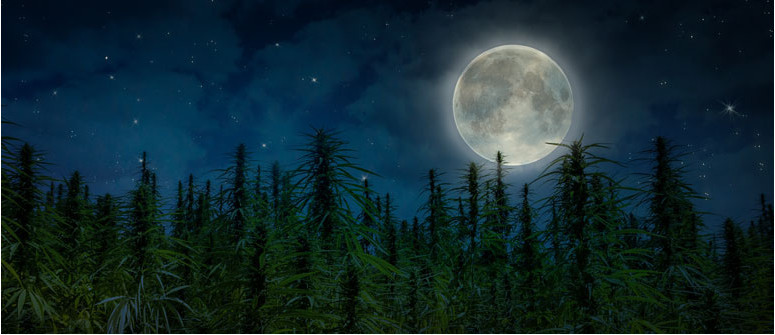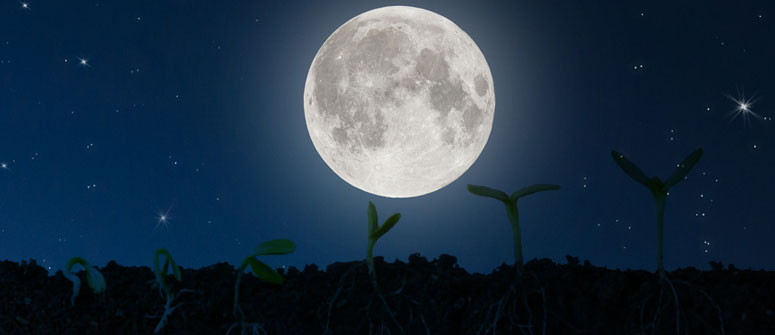Moon gardening and cannabis: using the moon for a better grow

Moon gardening is an ancient practice that involves following the lunar calendar when planting. Click here to see how this applies to cannabis.
The moon is known to affect life on earth in a variety of ways. It can affect the breeding habits of animals, the tidal levels of the ocean, and even the menstruation cycles of women.
An old school of gardening (followed by native peoples like the Native Americans) known as lunar or moon gardening focuses on how the moon can affect the growth, development, and harvest of plants and crops. More specifically, lunar gardening focuses on following a particular lunar calendar in order to maximize the health and yield of your garden.
Now, modern cannabis gardeners are picking up on these old traditions and finding that, by paying close attention to the moon and its monthly orbit around the earth, they’re able to produce bigger, higher-quality yields every time.
WHAT IS MOON GARDENING?
Moon gardening, also known as lunar gardening, is an old gardening practice that involves planting certain crops at different times of the moon’s monthly orbit around planet earth. It has been practiced by gardeners all across the world for centuries.
While we don’t want to get too technical about astrology, it is important to have a basic understanding about the moon’s orbit in order to better understand the theory behind lunar planting.
One lunar orbit around the world takes roughly 27 days. In this time, the moon travels through each of the 12 zodiac signs. Just like the moon’s gravitational pull affects the tides, lunar gardeners suggest it may also affect the rate of germination in seeds and the overall size and quality of your harvest.
The two main theories behind lunar planting are:
- Plants that bear fruit or flowers above ground should be planted during the “waxing” of the moon (or when it goes from new moon to full moon).
- Plants that produce crops below ground as well as biennial and perennial flowers should be planted during the moon’s “waning” period (or when it goes from full to new moon).
Some lunar gardeners also suggest that the moon’s gravitational pull can affect moisture levels in the soil by pulling moisture closer to the soil’s surface, ultimately improving the chances of seeds germinating properly.
Finally, some lunar gardeners will also pay close attention to the moon’s orbit through the zodiac. Zodiac signs are related to each of the 4 elements; Capricorn, for example is considered an earth sign.
Here is a basic breakdown of the 12 zodiac signs based on their respective element:
- Cancer, Scorpio, and Pisces = Water
- Gemini, Libra, and Aquarius = Air
- Taurus, Virgo, and Capricorn = Earth
- Aries, Leo, and Sagittarius = Fire
Moon gardeners suggest sowing seeds as the moon passes through specific zodiac constellations, especially those related to water and earth, for a particularly fruitful harvest. Planting in constellations related to fire, on the other hand, is believed to produce smaller harvests.
WHAT ARE THE BENEFITS OF MOON PLANTING?
Moon gardeners suggest that following and studying the lunar orbit allows them to get greater insight into when to sow certain seeds.
This ultimately allows them to have greater control over their plants and maximize the size and quality of their harvests.
So, now you know a little more about lunar planting and how it works. Here are some simple ways you can apply some lunar planting principles to your cannabis grow:
GERMINATE SEEDS DURING THE FULL MOON

As we mentioned earlier, lunar gardeners suggest that the moon’s gravitational pull can affect the speed and rate of germination in seeds by affecting moisture content in the soil.
To take advantage of this, it is generally recommended to sow seeds during a full moon. During this time, the moon is believed to pull water closer to the surface of the soil, which is exactly where you’ll be planting your seeds. Seeds are also believed to be able to absorb more moisture during this time.
Cannabis seeds need plenty of moisture to germinate and taking advantage of the full moon is a great natural way to give them the best possible conditions.
KNOW YOUR MOONS
Ancient cultures such as the Native Americans observed the moons to keep track of time. To help them do so, tribes began naming the 12 moons of the year after particular activities or seasonal changes they noticed in the environment around them.
For example, the moon of February was known as the Snow or Hunger moon, portraying the heavy snow fall at this time of the year and the difficulty hunting or gathering food for the tribe. The full moon of April, on the other hand, was named the pink moon after the appearance of wild ground phlox, often one of the first spring flowers.
For cannabis growers, arguably the most important moon’s are those of April/May (known as the Pink and Flower moon, respectively) and the Harvest Moon of October/September. Studying the different moons will help you keep track of the flowering period of the years and the different stages of your plants growth
Keep in mind that these names originated from Native American tribes so they are particular to the seasonal patterns in the Northern Hemisphere.
PAY ATTENTION TO WAXING AND WANING PERIODS
The waxing and waning periods of the moon are generally associated with two different parts of a plant's development. Plants are believed to do most of their above-ground growing during waxing periods, while developing strong root systems during waning periods.
During the waxing moon, plants are believed to absorb more nutrients from their soil. This is a great time to provide your plants with any nutrients like fertilizers as well as treat any nutrient deficiencies they may have. Pruning is also believed to be least stressful on plants during waxing or new moon periods.
Waning periods, on the other hand, are believed to be the ideal time to deal with pest problems. This is also a great time to transplant or create clones as it’s the time of the month when plants focus on growing strong root systems below ground. For best results, try transplanting or cloning when the waning moon is in a Earth-related Zodiac sign, such as Taurus, Virgo, or Capricorn.
KNOW WHEN TO HARVEST
Harvest time is probably the most exciting time for most cannabis growers, and timing it right can make a huge difference to the quality of your yield.
Lunar gardeners will generally suggest harvesting during a new moon. This is when water levels in plants are believed to be at their lowest, which can make for shorter curing/drying times.
Meanwhile, your nutrient flush should usually take place during a waxing moon. This will help maximize water absorption and make for a clean harvest.
Finally, the ideal harvest time for flowers like cannabis is believed to be during air constellations such as Gemini, Libra, and Aquarius.
FORGET SUPERSTITION
In today’s society, old theories like the Zodiac or lunar gardening are often dismissed as outdated superstitious practices. However, there are countless gardeners who swear by the lunar calendar. Plenty of scientific research also went into this field, especially during the 20th century.
Some authors you may want to follow up on for more information on lunar gardening include:
- Maria Thun, author of the Biodynamic Calendar
- Nicholas Kollerstrom and Gerhard Staudenmaier, authors of Evidence for Lunar-Sidereal Rhythms in Crop Yield: A Review
- E.A. Crawford, author of The Lunar Garden: Planting by the Moon Phases.
Happy growing!




